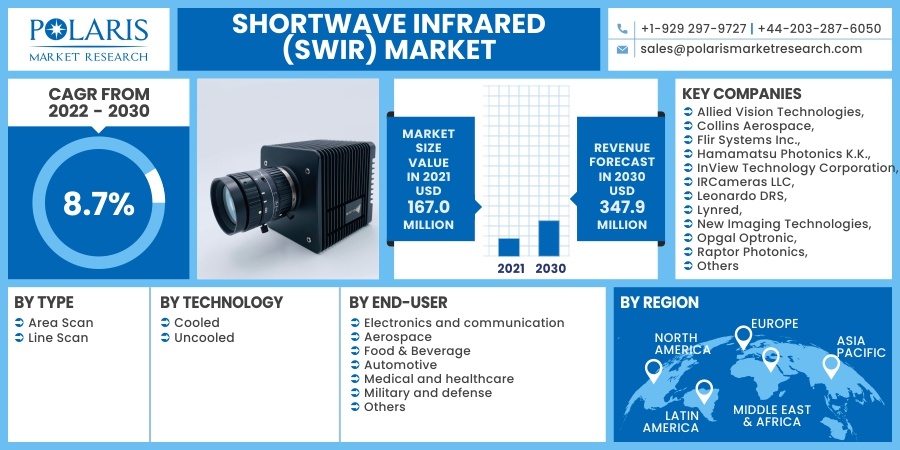
Shortwave Infrared (SWIR) Market Share, Size, Trends, Industry Analysis Report, By Type; By Technology (Cooled Infrared Imaging, Uncooled Infrared Imaging); By End-User; By Region; Segment Forecast, 2022 - 2030
- Published Date:May-2022
- Pages: 118
- Format: PDF
- Report ID: PM2396
- Base Year: 2021
- Historical Data: 2018 - 2020
Report Outlook
The global shortwave infrared (SWIR) market was valued at USD 167.0 million in 2021 and is expected to grow at a CAGR of 8.7% during the forecast period. Introduction of disruptive technologies, the wide applications of SWIR cameras have expanded in several verticals, driving the market.
 Know more about this report: Request for sample pages
Know more about this report: Request for sample pages
The capacity of the InGaAs image, which can capture high-quality images, and the growing demand for shortwave IR cameras in military operations also drive the industry forward. Numerous governments have taken steps to secure the military by upgrading the necessary defense, and military equipment will undoubtedly positively impact the shortwave infrared (SWIR) market.
SWIR cameras are now utilized for a variety of purposes. Even for vehicle navigation, there has been an increase in demand. SWIR technology can be beneficial in navigating adverse conditions such as fog, snow, or dust. Shortwave infrared camera's ability to distinguish between colors and analyze properties of materials such as air temp, water vapor, and chemical composition makes them perfect for applications such as craft inspection, spectrometry, and astronomy. Climate change experiments, ecosystem evaluation, microbe and disease assessment, ergonomics, and psychology are just a few scientific research applications where SWIR cameras have seen increased use. Water-cooled or fan-cooled systems are used in these cameras to reduce sound waves in telescopes.
Further, SWIR cameras are widely used in the food & beverage and agriculture industries, resulting in lower operational costs and higher work efficiency. Shortwave IR cameras' ability to detect the moisture of the soil and other surfaces allows them to be used in conjunction with drones to investigate agricultural production, identify areas with little or sufficient water, and evaluate food dryness or ripeness.
Industry Dynamics
Growth Drivers
Rising adoption of shortwave IR from the military and defense sector and the contracts among public and private players. Shortwave IR camera absorption in the military & defense vertical is growing. Their possibility to see through harsh environments such as fog, vapors, haze, and water vapor has resulted in higher usage in various applications such as marine intelligence, monitoring, and vision enhancement.
The capacity of SWIR cameras to see beyond the vehicle windscreens during both day and night, except for longwave infrared (LWIR) and mediumwave infrared (MWIR) thermal sensors, as well as their ability to recognize and differentiate between exponential and nonexplosive objects, expands the applications of SWIR camera systems for special-operation military vehicles. Moreover, in March 2021, Intevac announced a USD 1.8 million advancement contract award from the Joint Directed Energy Transition Office (DE JTO). The company will establish a "Gated SWIR Sensor" for the High Energy Laser (HEL) 2D Fine Tracking and Flexible Optics system applications within this contract.
In April 2021, Airbus Defence, the company responsible for the "European Copernicus Land Surface Temperature Monitoring (LSTM)" mission, has assigned Lynred, a supplier of infrared (IR) detectors, to construct a better linear shortwave-infrared (SWIR) array to meet the particular qualities. This array would be combined with the dedicated high-resolution radiometer to measure the earth's surface temperature increases.
The overall goal of LSTM is to improve long-term crop productivity at the field level in areas with growing water scarcity and climate variability. Thus, the contracts among the significant players for investment in the advancement of SWIR technology for the defense sector and the adoption of SWIR technology for the military and defense sector are contributing to the development of the shortwave infrared (SWIR) market.

Know more about this report: Request for sample pages
Report Segmentation
The market is primarily segmented based on type, technology, end-user, and region.
|
By Type |
By Technology |
By End-User |
By Region |
|
|
|
|
Know more about this report: Request for sample pages
Insight by Type
The area scan segment is expected to be the most significant revenue contributor in the global market. The area scan shortwave IR cameras can be attributed to their widespread adoption across multiple verticals. Shortwave IR cameras are process industries, industrial heating system monitoring, solar cell safety checks, driver vision augmentation, imaging through atmospheric obscurants, and surveillance systems, among area scan applications.
Geographic Overview
In terms of geography, North America had the largest revenue share. The major market segments that account for a significant percentage of the shortwave IR market in North America are military and defense, industrial, and commercial. The United States has the highest defense spending globally and is a primary SWIR cameras and technology market. Furthermore, this region has seen increased demand for these cameras, mainly cooled SWIR cameras, from the scientific research sector.
Moreover, Asia Pacific is expected to witness a high CAGR in the global shortwave infrared (SWIR) market. Due to high industrialization and infrastructure development in Taiwan and China, Asia Pacific is expected to dominate the market. Developing markets such as the Middle East and Africa, and South America are also expected to grow during the forecast period.
Competitive Insight
Some of the major players operating in the global shortwave infrared (SWIR) market include Allied Vision Technologies, Collins Aerospace, Flir Systems Inc., Hamamatsu Photonics K.K., InView Technology Corporation, IRCameras LLC, Leonardo DRS, Lynred, New Imaging Technologies, Opgal Optronic, Princeton Infrared Technologies, Inc., Raptor Photonics, Sensors Unlimited (United Technologies Company), Teledyne FLIR, and Xenics.
Shortwave Infrared (SWIR) Market Report Scope
|
Report Attributes |
Details |
|
Market size value in 2021 |
USD 167.0 Million |
|
Revenue forecast in 2030 |
USD 347.9 Million |
|
CAGR |
8.7% from 2022 - 2030 |
|
Base year |
2021 |
|
Historical data |
2018 - 2020 |
|
Forecast period |
2022 - 2030 |
|
Quantitative units |
Revenue in USD billion and CAGR from 2022 to 2030 |
|
Segments covered |
By Type, By Technology, By End-User, By Region |
|
Regional scope |
North America, Europe, Asia Pacific, Latin America; Middle East & Africa |
|
Key Companies |
Allied Vision Technologies, Collins Aerospace, Flir Systems Inc., Hamamatsu Photonics K.K., InView Technology Corporation, IRCameras LLC, Leonardo DRS, Lynred, New Imaging Technologies, Opgal Optronic, Princeton Infrared Technologies, Inc., Raptor Photonics, Sensors Unlimited (United Technologies Company), Teledyne FLIR, and Xenics. |
